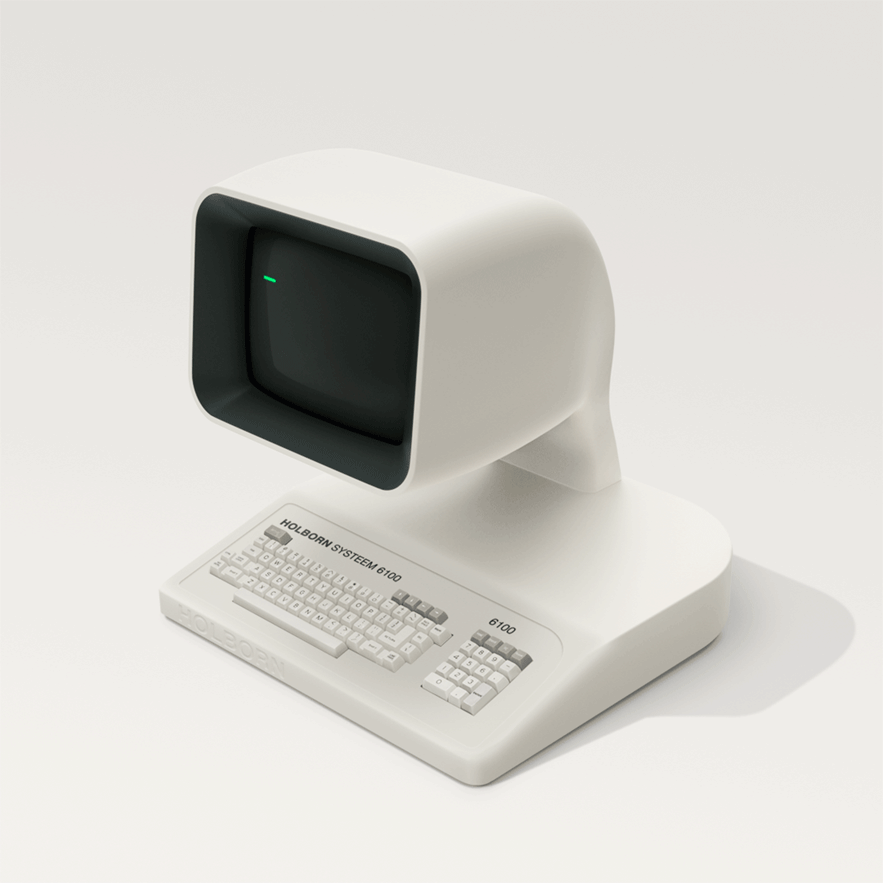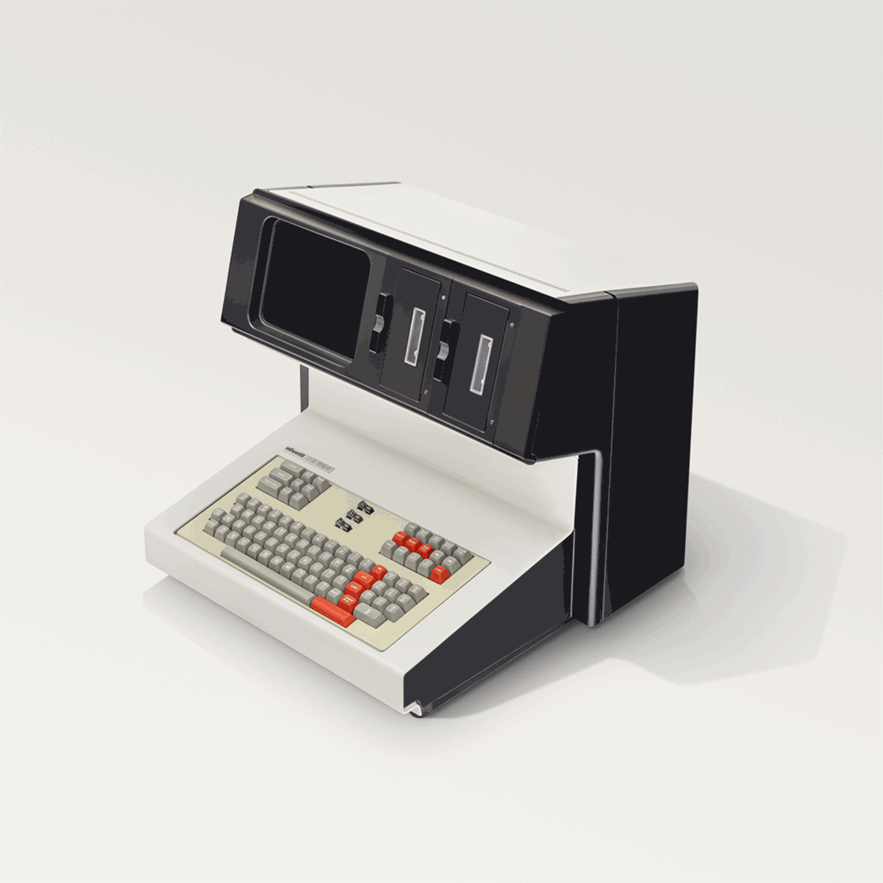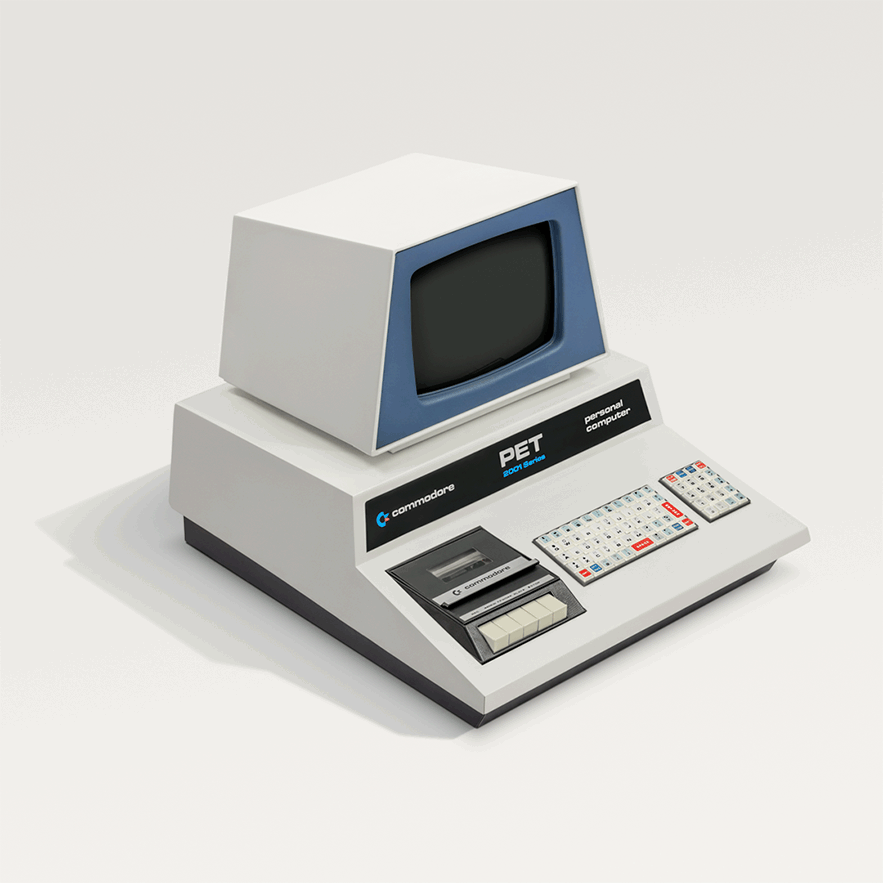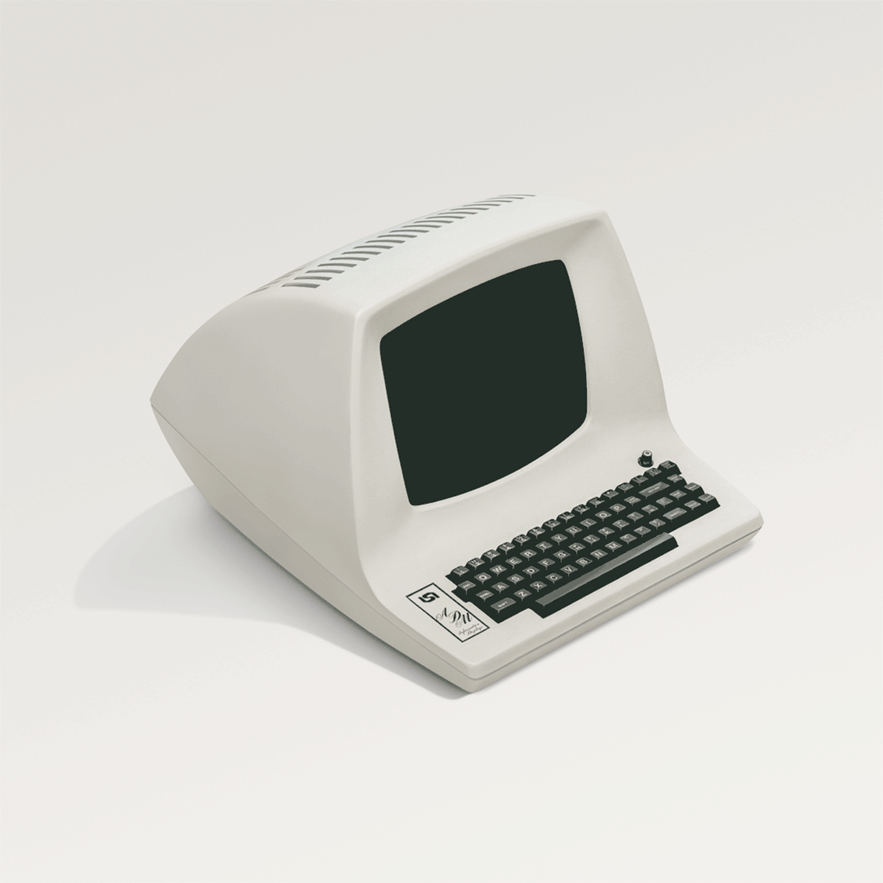
10/2018 design & fashion visual culture
In a pre-internet world existed crazy shaped beige computers with colorless monitors and clunky keyboards. This glorious period in computing history has been visually captured by photographer and art director James Ball (also known as Docubyte). Through his 'I am a computer' series, he takes us on a nostalgic journey back in time to the golden age of computer design.
 I am a Holborn 6100 by James Ball (Docubyte). Designed by Dutch industrial design studio 'Vos' on behalf of Holborn, the 6100 was one of the most unusual futuristic designs in the series. The company produced about 200 machines and faced competition from IBM. Retailed as high as $10,000 at the time, the machine was a failure and eventually forced Holborn to declare bankruptcy in 1983.
I am a Holborn 6100 by James Ball (Docubyte). Designed by Dutch industrial design studio 'Vos' on behalf of Holborn, the 6100 was one of the most unusual futuristic designs in the series. The company produced about 200 machines and faced competition from IBM. Retailed as high as $10,000 at the time, the machine was a failure and eventually forced Holborn to declare bankruptcy in 1983.
Technology is beautiful, it moves fast and changes quickly like trends, it doesn't follow a formula and there are always ups-and-downs. What is a classic to someone might be dated technology to another person. Much of the modern world may struggle to recall a time before gold iPhones, before Google was a word, and an era where you had to decide between using the landline or dial-up internet.
Fast-forward over three decades and the word ‘Computer’ has started fading out of the dictionary and modern use–Apple's 2017 iPad commercial showed a young protagonist asking, "What's a computer?" This portrayal of a computerless world infuriated members of the public, showing that society still cherishes computers. This was one of the reasons that inspired Ball to put this era of computer design back in the limelight.
‘I am a computer’ captures the futuristic, creative and stylish designs of this era that helped pave the way for the device you are probably reading this from now
James Ball is a technology-driven digital creator that has transformed the way we look at a Commodore Pet computer from 1977 or a 1984 Apple Macintosh. He does this by fusing color and subtle restorative manipulation techniques together, which allow him to turn vintage machines to modern art pieces. He puts this classic computer fascination down to being a Xellenial, a person that has an analog past and digital present born between 1977 and 1983. This period is important to Ball because it marked a new era for technology as you could now own a computer small enough to fit on a desk, previously they were the size of vehicles. The IBM 5150 became the first 'Personal Computer' in the world and fuelled our obsession for owning personal devices.
 I am an Olivetti DE 523 by James Ball (Docubyte). Made in 1975 by the Italian company, the DE 523 was a word processor, comprising an integrated unit with screen, 2 cassette tape drives and keyboard in a single casing. The keyboard had special function keys devoted to word processing. Celebrated for its 'futuristic' design at the time, the monochrome monitor was supported by an arm reaching up from behind the keyboard.
I am an Olivetti DE 523 by James Ball (Docubyte). Made in 1975 by the Italian company, the DE 523 was a word processor, comprising an integrated unit with screen, 2 cassette tape drives and keyboard in a single casing. The keyboard had special function keys devoted to word processing. Celebrated for its 'futuristic' design at the time, the monochrome monitor was supported by an arm reaching up from behind the keyboard.
'I am a computer' captures the futuristic, creative and stylish designs of this era that helped pave the way for the device you are probably reading this from now. The 1970s to early 1980s are particularly interesting to him because this was a time when computer manufacturers aspired towards both angular and sculptural forms of design, giving them a futuristic-edge with character and personality. He notes that after this period, PCs became blander and indistinguishable as we passed the 1980s and headed toward the Millennium.
When the computers were digitally restored to their former glory and had a box-fresh exterior, Ball animated each computer frame by frame until they became visually engaging masterpieces
In a time of disposable technology, Ball cleverly brings back the elegance of computers such as the Interdec Data Systems Superbrain from 1979, Hp 9845b Series from 1980, and Wang 2200 from 1973, plus dozens of other devices through painstakingly difficult retouching processes. He first had to approach various museums around the UK to gain access to this world of vintage computers. Once in, he shot every machine in a quasi-orthographic style that turned these beige objects into design art through cleaning up their various conditions. When the computers were digitally restored to their former glory and had a box-fresh exterior, Ball animated each computer frame by frame until they became visually engaging masterpieces.
 I am a Commodore Pet by James Ball (Docubyte). Considered by many as the first successful home computer, the Commodore PET 2001 (Personal Electronic Transactor) points it iconic angular design to Stanley Kubrick's cult-classic film 2001: Space Odyssey. The original PET created a successful product line for the company despite complaints about its ‘chiclet’ keyboard.
I am a Commodore Pet by James Ball (Docubyte). Considered by many as the first successful home computer, the Commodore PET 2001 (Personal Electronic Transactor) points it iconic angular design to Stanley Kubrick's cult-classic film 2001: Space Odyssey. The original PET created a successful product line for the company despite complaints about its ‘chiclet’ keyboard.
An analog veteran, photographer and digital creator, Ball has established himself as a still life master through his ability to give relevance to the technology of yesteryear. Ball puts a new perspective on these vintage computers through his styling and photography. His work takes you on a nostalgic journey into the evolution of design within technology, while also paying homage to that era that opened the door for much of the technology we take for granted today. ‘I am a computer’ pushes back from the shackles of ‘more is better’ and transports us back to a time when simplicity was beautiful. Before Instagram or Netflix existed dark backgrounds and green typography, it was a time when design was king and technology looked to the future.
 I am a ADM-3A Terminal by James Ball (Docubyte). Released in 1977, the ADM-3A was an iconic compact video terminal that became popular with early personal computer builders due to its relatively low retail price ($995 in kit form, $1,195 assembled). Standing for American Dream Machine, the ADM was hugely successful despite drawbacks as a so-called 'dumb terminal'. The ADM-3A had a reputation for its inability to perform computational tasks and could only display upper case letters.
I am a ADM-3A Terminal by James Ball (Docubyte). Released in 1977, the ADM-3A was an iconic compact video terminal that became popular with early personal computer builders due to its relatively low retail price ($995 in kit form, $1,195 assembled). Standing for American Dream Machine, the ADM was hugely successful despite drawbacks as a so-called 'dumb terminal'. The ADM-3A had a reputation for its inability to perform computational tasks and could only display upper case letters.
The art of still life continues its resurgence into contemporary society, through magazines to social media, James Ball isn't alone in taking still life into new directions. Explore the product portraits of some of our time's most creative photographers, designers, and stylists through our The Still Life book.





 I am a Holborn 6100 by James Ball (Docubyte). Designed by Dutch industrial design studio 'Vos' on behalf of Holborn, the 6100 was one of the most unusual futuristic designs in the series. The company produced about 200 machines and faced competition from IBM. Retailed as high as $10,000 at the time, the machine was a failure and eventually forced Holborn to declare bankruptcy in 1983.
I am a Holborn 6100 by James Ball (Docubyte). Designed by Dutch industrial design studio 'Vos' on behalf of Holborn, the 6100 was one of the most unusual futuristic designs in the series. The company produced about 200 machines and faced competition from IBM. Retailed as high as $10,000 at the time, the machine was a failure and eventually forced Holborn to declare bankruptcy in 1983. I am an Olivetti DE 523 by James Ball (Docubyte). Made in 1975 by the Italian company, the DE 523 was a word processor, comprising an integrated unit with screen, 2 cassette tape drives and keyboard in a single casing. The keyboard had special function keys devoted to word processing. Celebrated for its 'futuristic' design at the time, the monochrome monitor was supported by an arm reaching up from behind the keyboard.
I am an Olivetti DE 523 by James Ball (Docubyte). Made in 1975 by the Italian company, the DE 523 was a word processor, comprising an integrated unit with screen, 2 cassette tape drives and keyboard in a single casing. The keyboard had special function keys devoted to word processing. Celebrated for its 'futuristic' design at the time, the monochrome monitor was supported by an arm reaching up from behind the keyboard. I am a Commodore Pet by James Ball (Docubyte). Considered by many as the first successful home computer, the Commodore PET 2001 (Personal Electronic Transactor) points it iconic angular design to Stanley Kubrick's cult-classic film 2001: Space Odyssey. The original PET created a successful product line for the company despite complaints about its ‘chiclet’ keyboard.
I am a Commodore Pet by James Ball (Docubyte). Considered by many as the first successful home computer, the Commodore PET 2001 (Personal Electronic Transactor) points it iconic angular design to Stanley Kubrick's cult-classic film 2001: Space Odyssey. The original PET created a successful product line for the company despite complaints about its ‘chiclet’ keyboard. I am a ADM-3A Terminal by James Ball (Docubyte). Released in 1977, the ADM-3A was an iconic compact video terminal that became popular with early personal computer builders due to its relatively low retail price ($995 in kit form, $1,195 assembled). Standing for American Dream Machine, the ADM was hugely successful despite drawbacks as a so-called 'dumb terminal'. The ADM-3A had a reputation for its inability to perform computational tasks and could only display upper case letters.
I am a ADM-3A Terminal by James Ball (Docubyte). Released in 1977, the ADM-3A was an iconic compact video terminal that became popular with early personal computer builders due to its relatively low retail price ($995 in kit form, $1,195 assembled). Standing for American Dream Machine, the ADM was hugely successful despite drawbacks as a so-called 'dumb terminal'. The ADM-3A had a reputation for its inability to perform computational tasks and could only display upper case letters.


